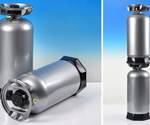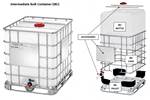Make PET Containers From 20 ml to 5 L on One Machine
Cypet’s new PRO Series of one-stage injection stretch-blow molding (ISBM) machines boasts high flexibility, high output, fast payback.
New Cypet PRO Series ISBM machines separate preform injection from conditioning and stretch-blowing in adjoining enclosure. Source: Cypet
The latest generation of PET injection stretch-blow molding machines from Cypet Technologies of Cyprus boasts higher productivity than the firm’s existing K Series. Unlike the latter, the new PRO Series does not combine injection and blowing molds in the same clamp. Like the K Series, the new models are based on a horizontal injection press for preform injection (four sizes from 200 to 530 tons). Immediately beside that press is a rectangular enclosure housing preform conditioning and stretch-blowing stations, plus a floor-mounted six-axis robot to transfer preforms from the injection mold to the other two stations.
Six-axis robot transfers preforms from injection station to conditioning station (foreground) and to blowing station (background), then places bottles on exit conveyor (left). Source: Cypet
Cypet says the separation of the clamping units provides more space for higher cavitation and much faster dry cycles than with the K Series. Both factors are said to provide two to three times higher productivity for PET bottles up to 5 L. Even for larger bottles, productivity is said to be enhanced significantly with the PRO Series. The new layout also places all the machine modules on ground level, which facilitates maintenance and mold changes, at the expense of additional floor space. Finished bottles exit the machine on a conveyor.
Another new feature is the addition of a conditioning station to adjust and optimize the preform temperature both along its length and around its circumference. This means the machine can optimize preform temperatures for oval, square and asymmetric bottles just by changing settings on a screen.
Cypet highlights the flexibility of the PRO Series — its five models can produce PET bottles and jars from 20 ml to 50 L. One model can make containers from 50 ml to 5 L. All functions of the machines are servo-electric, except for hydraulic clamping for preform injection. Like the K Series, the new versions can mold integral handles and keep the same cavitation for injection and blow molds in order to provide identical heat history for all preforms before blowing.
Cypet quotes payback times of 18 to 24 months for the whole system, including auxiliaries and compressed air equipment. Here are examples of productivity cited by the company:
- In 48 cavities, 10,800 bottles per hour for 100-ml pharma bottles, 180-ml oval liquor bottles, 500-ml general bottles, and 1 L bottles for milk and edible oil; 9,600 bph for 100-ml pill packers.
- In 24 cavities, 5,400 bph for 53-mm-neck jars.
- In 18 cavities, 3,600 bph for 83-mm-neck jars.
- In 12 cavities, 1,964 bph for 120-mm-neck jars; 1,662 bph for 5 L bottles for water or edible oil.
Related Content
-
Foam-Core Multilayer Blow Molding: How It’s Done
Learn here how to take advantage of new lightweighting and recycle utilization opportunities in consumer packaging, thanks to a collaboration of leaders in microcellular foaming and multilayer head design.
-
Get Color Changes Right In Extrusion Blow Molding
Follow these best practices to minimize loss of time, material and labor during color changes in molding containers from bottles to jerrycans. The authors explore what this means for each step of the process, from raw-material infeed to handling and reprocessing tails and trim.
-
At NPE, Cypet to Show Latest Achievements in Large PET Containers
Maker of one-stage ISBM machines will show off new sizes and styles of handled and stackable PET containers, including novel interlocking products.







